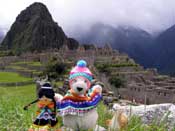Peru Travel Review

Peru History
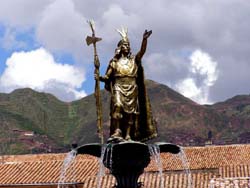 Native tribes lived in South America for centuries, with evidence revealing advanced cultures thriving in the region around 500 A.D. Called “the people of the sun”, the most widely recognized were the Incas- who thrived in the mountains from around 1400 to 1532 A.D. Spanish Conquistador Francisco Pizarro and his troops brutally conquered the Incas, Pizarro’s motive the vast deposits of gold and silver found in the Andes. Starting in the year 1533 A.D., the Spaniards overran the country and the vast Incan empire, which had stretched from near the Gulf of Mexico in the north down to present day Chile. The Incans seem to have literally disappeared, leaving no written language and no signs of their civilization except for a remarkable series of structures, immense stone monuments and temples all around the country.
Native tribes lived in South America for centuries, with evidence revealing advanced cultures thriving in the region around 500 A.D. Called “the people of the sun”, the most widely recognized were the Incas- who thrived in the mountains from around 1400 to 1532 A.D. Spanish Conquistador Francisco Pizarro and his troops brutally conquered the Incas, Pizarro’s motive the vast deposits of gold and silver found in the Andes. Starting in the year 1533 A.D., the Spaniards overran the country and the vast Incan empire, which had stretched from near the Gulf of Mexico in the north down to present day Chile. The Incans seem to have literally disappeared, leaving no written language and no signs of their civilization except for a remarkable series of structures, immense stone monuments and temples all around the country. Peru Locations of Interest
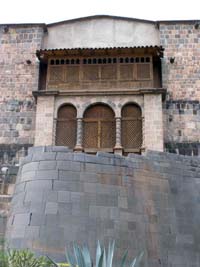 From the Amazon rainforests in the north to arid hinterlands in the south, Peru is a land of wonders. The beaches along the Pacific Coast offer a striking change of scenery from the dense jungles along the Amazon River and the jagged mountains inland. If these aren’t enough, visitors can travel to the southeastern corner of the country and see the highest navigable lake in the world. Peru is home to the Andes- the tallest mountain range outside the Himalayas- and the deepest regions on Earth, Colca Canyon being twice the depth the Grand Canyon. Although centuries ago they were the enemy, the Spaniards are celebrated everywhere throughout the country. The capital city of Cusco retains not only its Spanish heritage- it’s built on stones carved by the Incans. The lovely Colonial city of Lima on the west coast was once the ‘City of Kings’, a monument to Pizarro’s conquests. It boasts a beautiful cathedral with treasures of art from the past five centuries.
From the Amazon rainforests in the north to arid hinterlands in the south, Peru is a land of wonders. The beaches along the Pacific Coast offer a striking change of scenery from the dense jungles along the Amazon River and the jagged mountains inland. If these aren’t enough, visitors can travel to the southeastern corner of the country and see the highest navigable lake in the world. Peru is home to the Andes- the tallest mountain range outside the Himalayas- and the deepest regions on Earth, Colca Canyon being twice the depth the Grand Canyon. Although centuries ago they were the enemy, the Spaniards are celebrated everywhere throughout the country. The capital city of Cusco retains not only its Spanish heritage- it’s built on stones carved by the Incans. The lovely Colonial city of Lima on the west coast was once the ‘City of Kings’, a monument to Pizarro’s conquests. It boasts a beautiful cathedral with treasures of art from the past five centuries.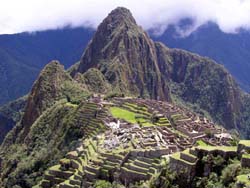 The greatest attraction is Machu Picchu, reached via a breathtaking train ride to the small town of Aguas Calientes. A bus runs regularly up the massive cliffs to the sacred city, spectacular in the morning mist. You’ll be astounded at the incredible precision of the stones laid for the buildings, put together by hand, without mortar, still standing after more than 500 years. Don’t forget to visit the Uros People, the only civilization which makes its home on a high altitude body of water- Lake Titicaca. There are so many places to see in Peru, you’ll want to plan at least a 7-day visit, although two weeks would be ideal.
The greatest attraction is Machu Picchu, reached via a breathtaking train ride to the small town of Aguas Calientes. A bus runs regularly up the massive cliffs to the sacred city, spectacular in the morning mist. You’ll be astounded at the incredible precision of the stones laid for the buildings, put together by hand, without mortar, still standing after more than 500 years. Don’t forget to visit the Uros People, the only civilization which makes its home on a high altitude body of water- Lake Titicaca. There are so many places to see in Peru, you’ll want to plan at least a 7-day visit, although two weeks would be ideal.Peru Customs and Culture
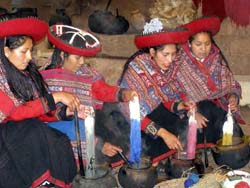 Although the larger cities are bustling, many Peruvians live a simple life. Quechua is their official language, but Aymara and hundreds of dialects are spoken around the country. Lovers of crafts will enjoy the exquisite silver and gold ornaments available at many roadside stands, along with beautiful wood carvings and clothing woven from pure alpaca wool. You’ll even be greeted by smiling llamas at many stops around the country.
Although the larger cities are bustling, many Peruvians live a simple life. Quechua is their official language, but Aymara and hundreds of dialects are spoken around the country. Lovers of crafts will enjoy the exquisite silver and gold ornaments available at many roadside stands, along with beautiful wood carvings and clothing woven from pure alpaca wool. You’ll even be greeted by smiling llamas at many stops around the country.
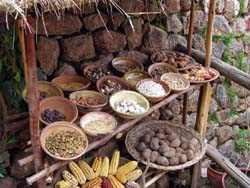 If you travel through the remote areas, you’ll see people living in mud-brick structures made by hand- some dotted with antennas and satellite dishes. A tasty option for breakfast is quinua, a staple grain. The Peruvian lunch and dinner menus will please those who are searching for something different, with a wide variety of fish such as corvina, chita and lenguado, cabrito (goat) and even llama. You can go from spicy (aji, peppers) to more bland (papas- potatoes, over 3,000 varieties) and everywhere in between. For the adventurous, they even serve a local delicacy- roasted guinea pig.
If you travel through the remote areas, you’ll see people living in mud-brick structures made by hand- some dotted with antennas and satellite dishes. A tasty option for breakfast is quinua, a staple grain. The Peruvian lunch and dinner menus will please those who are searching for something different, with a wide variety of fish such as corvina, chita and lenguado, cabrito (goat) and even llama. You can go from spicy (aji, peppers) to more bland (papas- potatoes, over 3,000 varieties) and everywhere in between. For the adventurous, they even serve a local delicacy- roasted guinea pig.
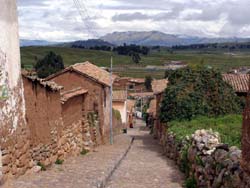 CAUTION: despite what ANY tour guide tells you about the water being safe in the finer hotels- you are taking a big risk drinking anything other than bottled water. Also- DON’T let anyone serve you a bottle of water that has already been opened- insist on opening it yourself (to avoid receiving one re-filled with tap water). Although Lima is at sea level, Cusco, Machu Picchu and Lake Titicaca are at 10,000+ feet above sea level and can cause altitude sickness. Take precautions with medication or other remedies to reduce the effects. Also, this is a rugged land and requires significant walking and climbing.
CAUTION: despite what ANY tour guide tells you about the water being safe in the finer hotels- you are taking a big risk drinking anything other than bottled water. Also- DON’T let anyone serve you a bottle of water that has already been opened- insist on opening it yourself (to avoid receiving one re-filled with tap water). Although Lima is at sea level, Cusco, Machu Picchu and Lake Titicaca are at 10,000+ feet above sea level and can cause altitude sickness. Take precautions with medication or other remedies to reduce the effects. Also, this is a rugged land and requires significant walking and climbing.
Peru's Top Five Attractions
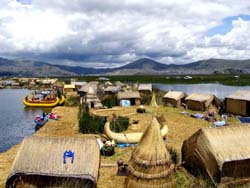 Any first time visitor to Peru will be well served by planning a mix of the ancient and more modern sites.
Any first time visitor to Peru will be well served by planning a mix of the ancient and more modern sites.
- Machu Picchu
- Lake Titicaca
- The Cathedral at Lima
- Cusco
- ancient ruins Ollantaytambo and Sacsayhuaman.
With more time: 1) the Amazon rainforest and 2) the mysterious, enigmatic Nazca Lines.
Prepare to be amazed- Peru is a place unlike any other on Earth.

